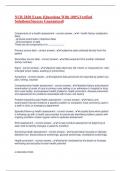Exam (elaborations)
AHA Pediatric Advanced Life Support 2023 Exam / PALS 2023 Exam (answered)
- Course
- Institution
- Book
PALS 2023 Exam (answered) 1. A 6 month old infant is unresponsive. You begin checking for breathing at the same time you check for the infants pulse. Which is the maximum time you should spend when trying to simultaneously check for breathing and palpate the infants pulse before starting CPR? ...
[Show more]












